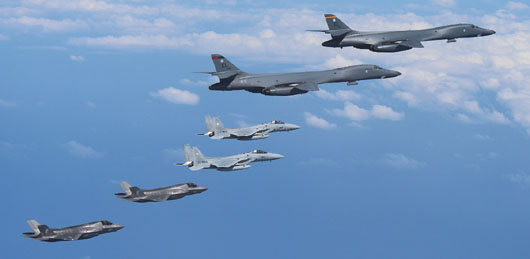by WorldTribune Staff, September 3, 2017
The show of force by the U.S. and its allies in response to North Korea’s intermediate-range ballistic missile test on Aug. 28 included U.S. Marine Corps F-35s and U.S. Air Force B-1B bombers joined for the first time in a “sequenced bilateral mission” that included Japan and South Korea’s air forces, according to the U.S. Pacific Command.

The Marine Corps F-35B Lightning IIs, the newest and most advanced U.S. fighter, joined the B-1B Lancers for a 10-hour mission over Northeast Asia on Aug. 30.
“The F-35 embodies our commitment to our allies and contributes to the overall security and stability of the Indo-Asia Pacific region,” said Lt. Gen. David H. Berger, commander, U.S. Marine Corps Forces Pacific.
The U.S. Air Force F-35A Lightning II will be declared fully combat ready this month. The Pentagon plans to deploy more than 100 F-35s in Asia over the next 3 years as China has fielded its own fifth generation fighters like the J-31.
“The F-35 was originally designed to work in tandem with the F-22 Raptor – the Raptor serving as an air superiority fighter while the Lightning II functioning more as a swing-role ‘Swiss army knife’ aircraft,” Business Insider reported.
“By forward-basing the F-35, the most advanced aircraft in the world, here in the Pacific, we are enabling the Marine Corps to respond quickly during a crisis in support of Japan, the Republic of Korea, and all our regional partners.”
Pacific Command said that two B-1Bs from Andersen Air Force Base in Guam and four U.S. Marine F-35Bs from Marine Corps Air Station Iwakuni, Japan were joined by two Koku Jieitai (Japan Air Self-Defense Force) F-15Js; and four Republic of Korea Air Force (ROKAF) F-15Ks.
Over the course of the 10-hour mission, the F-35Bs, B-1B bombers and Koku Jieitai fighters flew together over waters near Kyushu, Japan. The U.S. and South Korean aircraft then flew across the Korean Peninsula and practiced attack capabilities by releasing live weapons at the Pilsung Range training area before returning to their respective home stations, Pacific Command said.
Pacific Command said the mission was conducted in response to North Korea’s intermediate-range ballistic missile launch, which flew directly over northern Japan on Aug. 28.
“North Korea’s actions are a threat to our allies, partners and homeland, and their destabilizing actions will be met accordingly,” said Gen. Terrence J. O’Shaughnessy, Commander, U.S. Pacific Air Forces.
“This complex mission clearly demonstrates our solidarity with our allies and underscores the broadening cooperation to defend against this common regional threat. Our forward-deployed force will be the first to the fight, ready to deliver a lethal response at a moment’s notice if our nation calls.”
Subscribe to Geostrategy-Direct __________ Support Free Press Foundation
